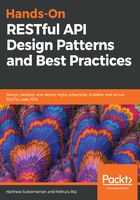
Learning about Web 3.0
The following sections focus on Web 3.0 and the evolution and history of web services.
Web 3.0 is generally referred to as executing semantic web, or read-write-execute web. Web 3.0 decentralizes services such as search, social media, and chat applications that are dependent on a single organization to function. Semantic and web services are the primary constituents of Web 3.0.
The following diagram depicts layers of typical Web 3.0 constructs. The semantic web layers are Static Web, Translations, and Rich Internet Applications (RIA) or Rich Web built on top of the internet:

This data-driven web adjusts according to the user's searches, for instance, if a user searches for architecture patterns, the advertisements shown are more relevant to architecture and patterns; it even remembers your last search and combines the last searched queries as well. Interesting isn't it?
What you see in the following diagram is a Web 3.0 stack, with various building blocks as URI, Unicode representations, syntax (XML/JSON), RDFS taxonomies, and so on; they constitute a Web 3.0 stack:

Let's move on to the web service architecture, the specifications, and the communication protocols, as they are the fundamentals before we move to ROA, SOA, and Representational State Transfer (REST) or RESTful services.